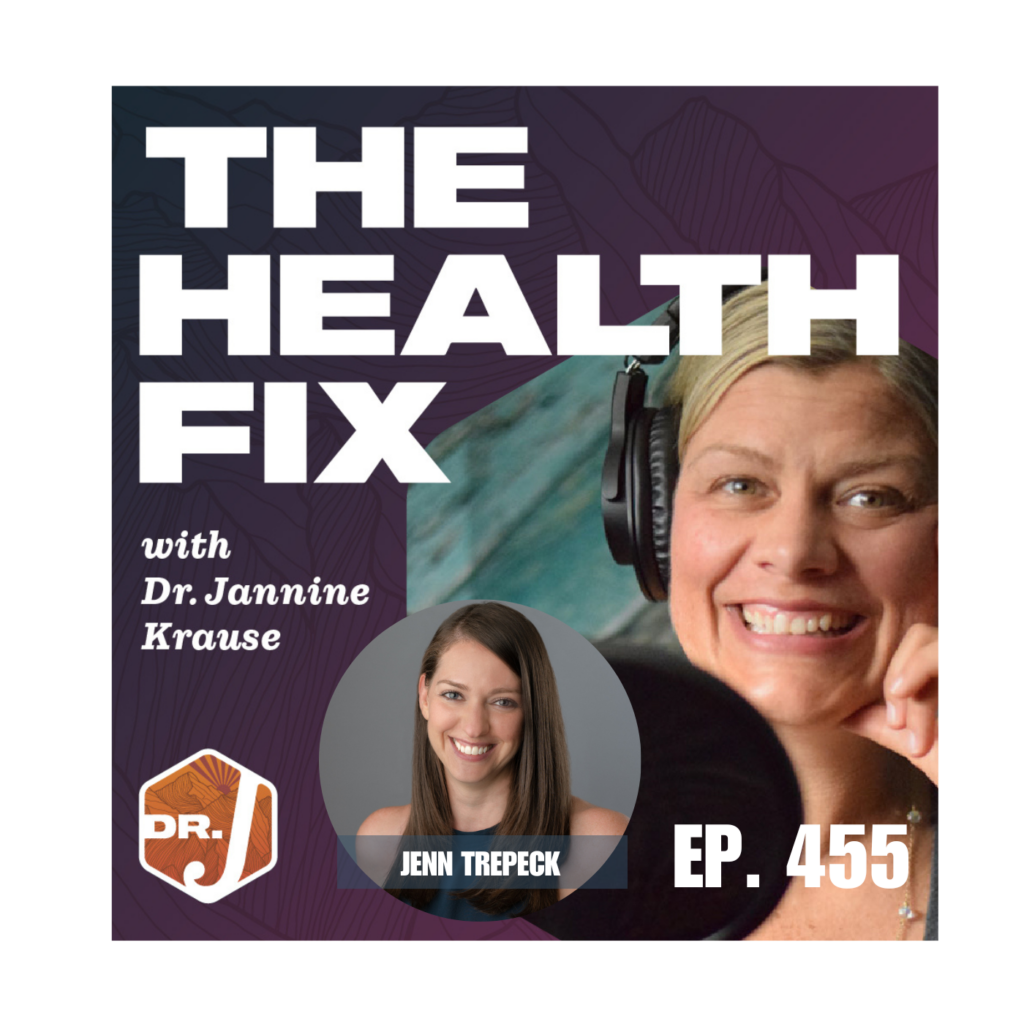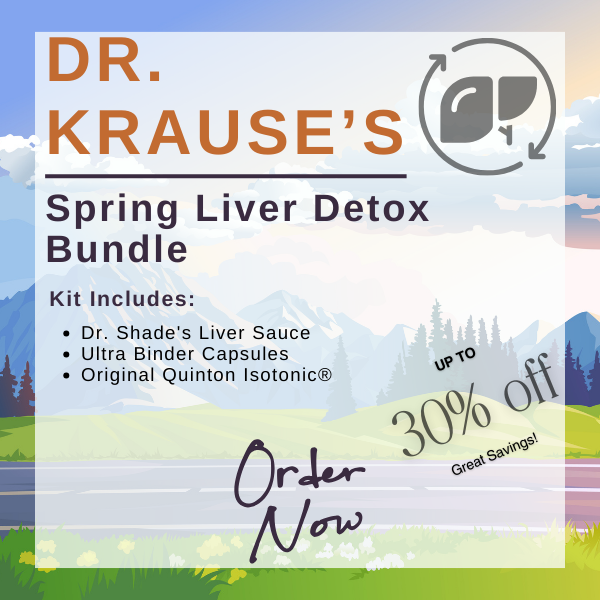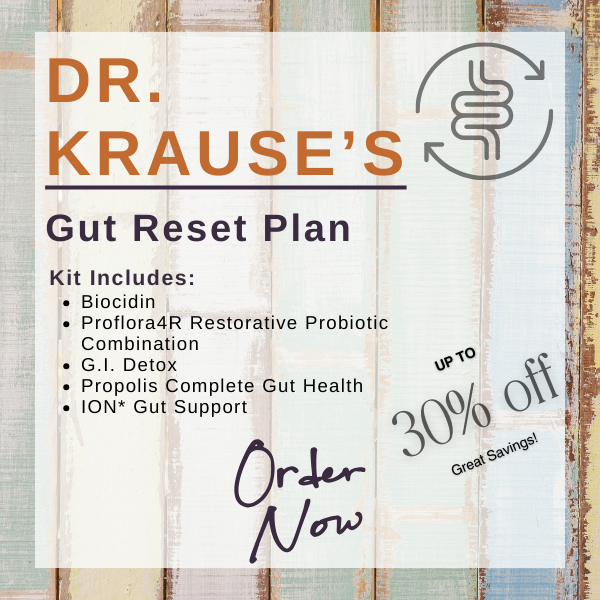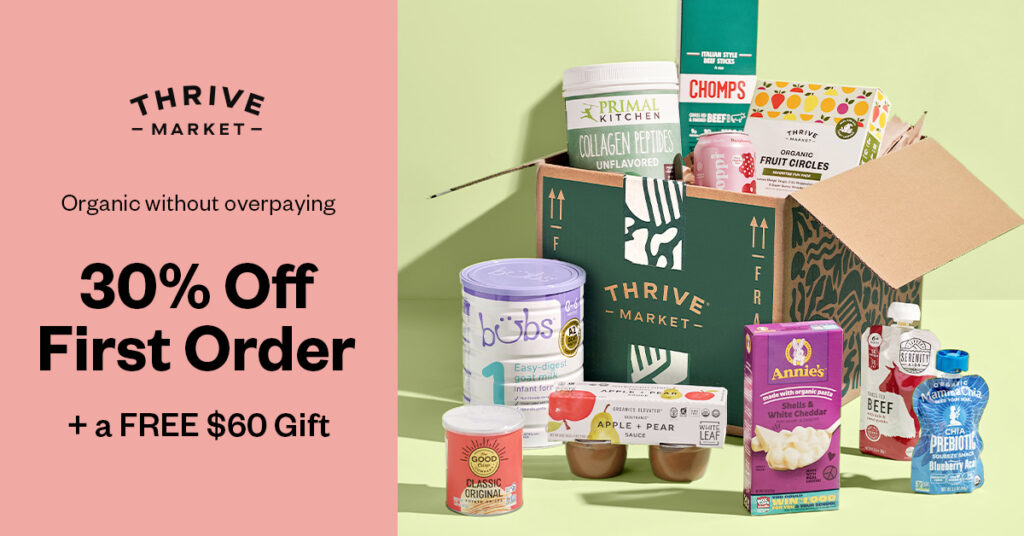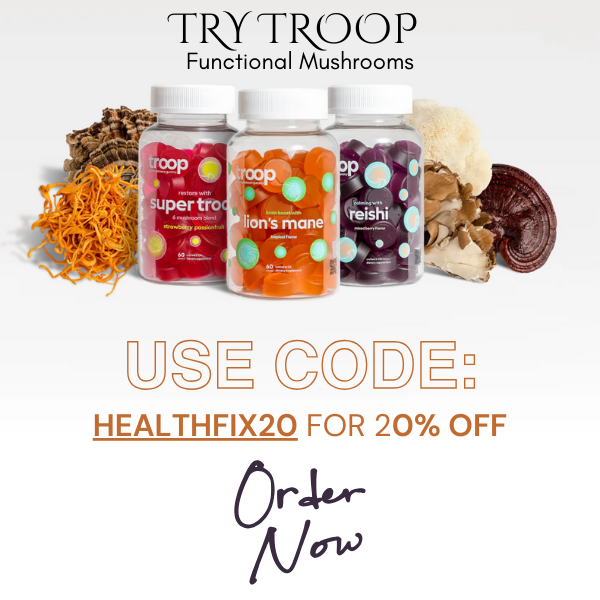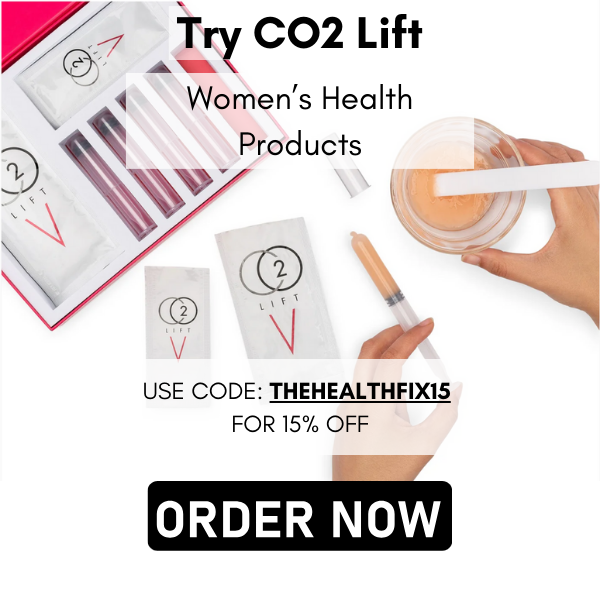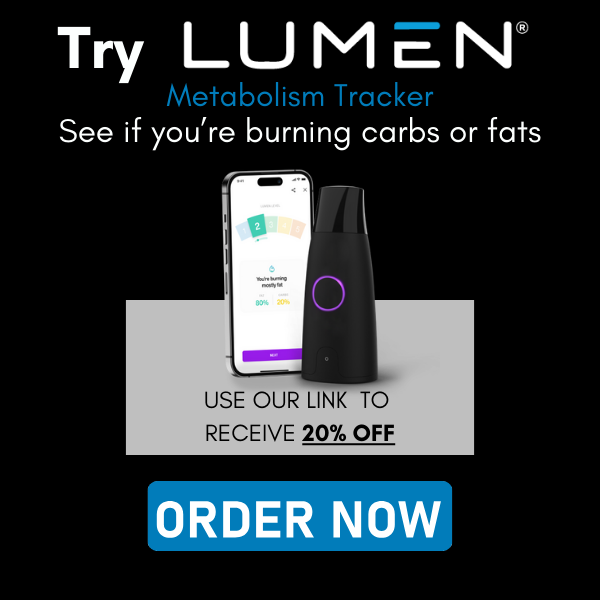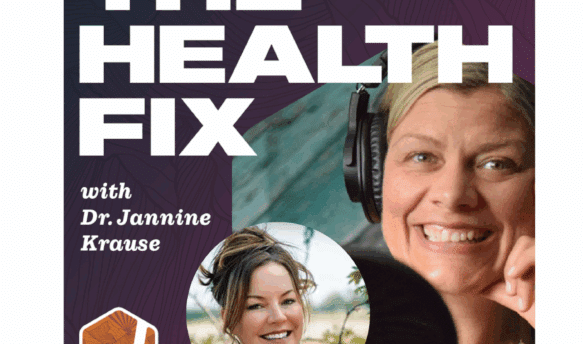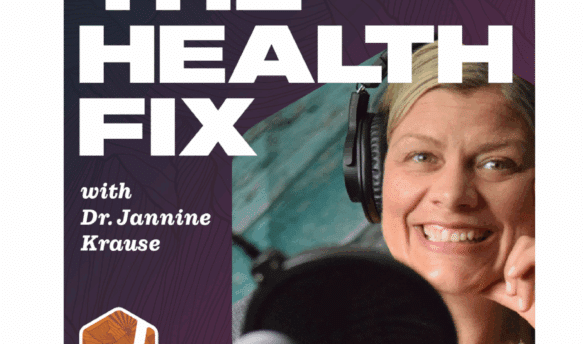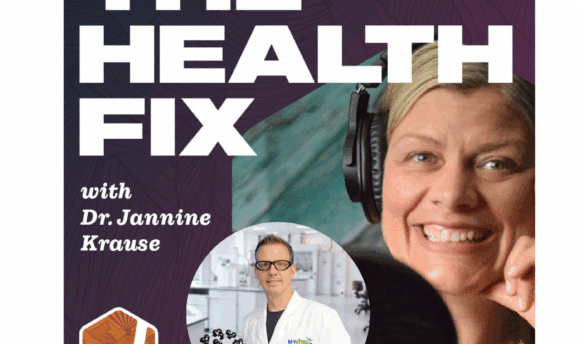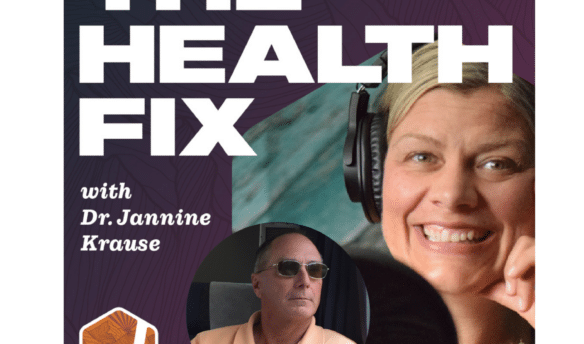Fed up with food trends and so much conflicting information out there from one guru to the next? Just want to know how food works on a basic level so you can personalize it to you? Jenn Trepeck is an Optimal Health Coach Business Consultant and host of the hilarious podcast Salad with a Side of Fries Podcast. Jenn grew up the skinny one in a family of dieters until it went away and her weight management saga began. Ultimately, Jenn learned the nutrition basics that are being overpowered by fancy protocols and hacks that aren’t sustainable. Now Jenn is on a mission to demystify how food works in the body to help people help themselves. In this episode of The Health Fix Podcast, Dr. Jannine Krause picks Jenn Trepeck’s brain on the most common food and diet trends as well as the health issues related to these “biohacks”!
Dr. Krause’s Protocols
Instructions Included
Traveling soon? Looking to detox or reset your gut? Try one of Dr. Krause’s Fullscript plans.
What You’ll Learn In This Episode:
- Cholesterol elevation is related to blood sugar balance more than fat intake
- Why caffeine of any kind on an empty stomach can cause hormone and metabolic issues
- How blood sugar imbalances are messing with your mood
- The connection between protein, blue lights from screens and night time eating
Resources From The Show:
Salad with a Side of Fries Podcast
It’s not what to eat – it’s how to eat – Jenn’s detailed pdf of what you need to know – click HERE and a form will appear
Want to chat with Jenn – click HERE for a complimentary exclusive for Health Fix Listeners
Jenn’s best salad & fries picks:
Leo’s Coney Island (Detroit Area) – Spinach with grilled chicken & onions –
Mark’s Off Madison and the Belgian Fries – NYC
Our Partners
Podcast Transcript
5:52 – Intermittent fasting
9:59 – Hangry
14:45 – Eating fats
19:06 – Should you just eat the egg whites?
19:32 – The meaning of “essential” nutrients
21:31 – Cholesterol and the connection to blood sugar
23:16 – LDL’s and Statins
25:43 – What would be considered good fiber for someone that struggles to get in a lot of veggies?
27:45 – Eating a salad for breakfast?
29:24 – Greens powder and supplements
32:11 – Jen’s favorite food hack
33:58 – The “dirty fast”
34:44 – Coffee before food
40:22 – Easiest way to improve our evening wind down routine
41:07 – Nighttime eating
44:47 – Biohacking
47:11 – Where to find Jenn | saladwithasideoffries.com
[Intro] Welcome to the Health Fix Podcast, where health junkies get their weekly
fix of tips, tools, and techniques to have limitless energy, sharp minds, and fit
physiques for life.
JANNINE: Hey health junkies! On this episode of Health Fix Podcast, I’m interviewing Jenn
Trepeck. She’s an optimal health coach, business consultant, and host of the
podcast, “Salad with a Side of Fries.” Jenn grew up in Michigan and she was the
skinny one in a family of dieters, which was awesome until it went away.
And so began her weight management saga.
Ultimately, Jenn learned the nutrition basics that are being overpowered by fancy protocols
and biohacks that aren’t sustainable.
Jenn is on a mission to demystify how food works in the body and help people help themselves.
With over a decade of working with clients, Jenn started Salad With a Side of Fries Podcast,
which is hilarious, and she decodes food research
and gets real on the basics you need to know
to simplify your relationship with food.
In this podcast, I get to pick Jenn’s brain
on the most common food trends in health issues
I see related to food, and my goodness,
she blows my mind with some connections I never thought of.
I have no doubt you’re going to learn a bunch
from Jenn’s experience with coaching clients
of all ages on food.
So let’s introduce you to Jenn Trepeck.
Hey, health junkies. I have a fun podcast for y’all today. I have Jenn Trepeck on and
we’re going to be talking about food, food and mood, and all the relationships with food
drama we have. And how do I get over that? So welcome to Health Fix Podcasts, Jenn.
JENN: Thank you so much for having me. I’m excited.
JANNINE: Man, when I looked at your podcast and started
listening to you and I saw Salad With a Side of Fries, I was like, yes, please. Thank
you.
JENN: Right?
JANNINE: So I’m guessing you were kind of coming
up with the podcast in terms of something relatable, but also something that maybe you’d experienced
a few times or wanted to experience.
JENN: Yeah. Yeah. Well, first of all, salad with a side of
fries was like my go to meal. And that’s how it became the name of the show. And now over
time, it’s gotten to the point where like, if that doesn’t resonate with you, like, I
don’t know that we’ll be friends. Just saying…
JANNINE: Oh my God.
JENN: And if you’ve never had it, no
No, judgment, now you need to order it and then decide if you’re in.
Right.
JANNINE: Well, yeah.
Yeah.
Because I mean
JENN: Right.
JANNINE: Let’s face it.
Okay.
I’m from the Midwest.
So right.
JENN: Me too.
Like I’m from Illinois, then
JENN: I grew up in Michigan.
JANNINE: All right.
So you know the drill, you know the drill.
JENN: for people.
Yeah.
JANNINE: Exactly.
Exactly.
And now like, you know, with Salad With a Side Of Fries, we’ve gotten fancy now, like
there’s like Parmesan fries.
There’s like truffle fries.
Yeah.
What do you choose?
you do it.
JENN: So my go to it depends what the options are. My go to is a sweet potato fried
just kind of hits the spot. But I also love a good steak fry. If they’re but but I’m picky.
So if they come and they’re soggy, I’m like, no, thank you.
JANNINE: Crispy?
JENN: Yes, crispy.
JANNINE: Yes. Exactly. My family orders them extra crispy on the East Coast.
I live in New York now. So I have to say, well done. When you say extra crispy, they’re like,
– Huh?
– It’s all right.
JANNINE: Interesting, interesting.
JENN: I know.
JANNINE: New York come on.
JENN: I know.
JANNINE: Get with the Midwest lingo, extra crispy.
We know what that means here.
And then cheese fries, like no, yes, poutines,
where you add on those, like with the side of fries too much.
JENN: So cheese doesn’t like me.
JANNINE: Mm, mm-hmm.
JENN: So on occasion, okay, but like poutine for me
is a challenge ’cause I don’t like the soggy.
JANNINE: Yeah, yeah.
JENN: It’s like you can maybe get like three or four bites
and then forget it.
So like you gotta share those.
JANNINE: I don’t do them, same thing,
’cause they can’t make them extra crispy.
Like or else I’m just gonna eat around the edge.
That’s why it’s not gonna work.
I feel the same about nachos.
No, okay, then salad, what’s your choice on salad?
I gotta know.
JENN: All salad.
JANNINE: Okay.
It depends on the mood, right?
But I could go for like an Asian inspired salad
or a salad that actually has no lettuce,
or just tons of veggies.
Also love a good Caesar.
I can go sweet or savory on my salads.
Like I’m kind of a salad connoisseur in the same way
that I love fries.
But it’s all, the whole premise, right?
Is that it’s all about balance.
It’s all about, and not, and by the way,
balance is not Monday to Friday,
my body is a temple and the weekends, my body is a frat house.
Like that’s not balanced either.
And we’ve been told it is we’ve been led to believe that that’s how you
figure this out or you have that quote unquote cheat day.
And that’s not what I’m saying with Salad & a Side of Fries.
JANNINE: This is good to know.
This is good to know.
Cause yes, there is the cheat day culture.
I usually cringe.
I’m like, oh
JENN: I know.
JANNINE: Cause yeah, the weekend for a lot of us,
I mean, I’ve been in naturopath for a while
and you look at the, you look at people’s meal,
or they meal recall and like everything’s cool
and then they get to Friday
and then all of a sudden you’re a priest
and it’s confession.
And they’re like, and so, we went to brunch.
And then after that, you know, oh,
so it’s a hard gig to find, you know,
what to do, right?
‘Cause there’s so much information out there.
So of course I like to bring folks
and that can help us figure out what in the world
to do in this department.
So one of the things that you and I talked about
before I hit record is the hangry thing,
the like getting ourselves too hungry
’cause ladies be loving to be like,
I’m intermittent fasting.
And so the point that I’m so freaking hungry
that I’m gonna eat everything.
That works, right?
Tell us.
(laughing)
Okay, so what’s your take?
Give us a scoop.
JENN: Okay, so I have so many thoughts.
I’m like, where do I start?
Let’s just start with the idea of intermittent fasting first.
JANNINE: Okay.
Okay.
JENN: Throw science and biology to the wind for a second
and go with me on this.
A vast majority of the American public
does not meet their daily nutrition requirements.
Minimum nutrition requirements,
given 24 hours a day to eat.
JANNINE: Yeah.
JENN: How do we think that’s going to happen
in shorter and shorter and shorter windows.
Just saying.
Okay.
Then we take into account that
women’s biologically women bodies,
if that was even English, but you know what I mean.
JANNINE: I’m following you.
I got it.
JENN: Have hormone biochemistry shifts
every single day.
So, right, because not just over life
when we have, you know, puberty
and then perimenopause, menopause, right?
We also have a 30-ish day cycle.
So which means literally every single day,
our biochemistry is different than the day before
in order to progress through that cycle.
So you’re not losing your mind
when you wake up in the morning
you feel completely different, like that’s actually biochemically true.
So, given that, we also need to support all of that biochemistry with nutrition.
And especially women with those hormones, depriving our body of nutrition does not signal
health.
signals stress and scarcity and famine. And that puts our body into protection mode, into
survival into you’re not going to kill me. I will survive. And the way I will survive
is holding on to everything you give me as fat so that I can survive in this famine.
So our better choice for health.
Now if you just want the number and the scale to move in the downward direction for a little
bit of time, great, go for it.
Eat less, right?
What we lose when that happens, the number on the scale goes down.
But what we’re removing is water, muscle, and bone.
The opposite of improved health, the opposite of improved metabolism.
So if we’re going to do this in a way that promotes health and longevity and joy for
that matter.
JANNINE: Yep.
JENN: Right.
We need to eat.
So my recommendation is to get fuel in your system within an hour to 90 minutes of waking
up.
And we want that first fuel to be high in protein.
You can also do fiber from vegetables or sometimes fruit and even some quality fat,
making sure that we get the protein at the start of the day.
Now we need protein throughout the day, but especially at that first meal so that we can
set the stage of our blood sugar.
Because what we also know from all the research is that whether we are burning fat or storing
fat, it’s tied to blood sugar.
And if our blood sugar is too high, and if our blood sugar is too low, we will be storing
fat.
That hangry comes from our blood sugar being too low to the point where our body is so
deprived of nutrients that we can’t even make what we need to be in a good mood.
Our body is signaling food now.
And when that happens, because we need fuel to the brain as quickly as possible, what
is it that we crave?
We crave.
Yes, the carby sugary, high glycemic things because they’re fast fuel.
That’s what’s going to get fuel to the brain as quickly as possible.
JANNINE: Yes, yes.
JENN: So you’re not broken when you have those cravings.
You’re not broken when you’re hangry.
It’s more about us realizing what’s actually happening so that we can then respond to what’s
actually happening versus how that’s making us feel in the moment.
JANNINE: Incredibly important.
Incredibly important.
And one of the things I did notice, because you know, I kind of jumped into the fasting
thing to see because I’m an analone.
I’ll try anything and see what happens.
But you know, it worked well for a while, of course, you know, and then when life got
busy and I was like, oh, I’ll just not eat because, you know, it’s easier.
I don’t have to eat them.
I’ll try to get all my protein in at night.
I couldn’t, like you said, it just was too much.
And I was like, I’m so full.
And then I go to bed and can’t sleep because I was trying to shove everything in by 8 p.m.
And so it becomes a problem.
JENN: And it’s also not how the body works.
The body doesn’t say, oh, I store the chicken as protein for use later.
The only way to store for later is fat.
So if we’re trying to cram everything in and hope that it’s going to last us later,
you know, to be our fuel for later, it’s not really understanding how the body works.
the intention is that you then induce the body to use fat as fuel.
But given the way most people approach intermittent fasting, or even keto for that matter,
we don’t actually induce the body to use fat as fuel.
And so we’re actually to better use fat as fuel is to get to a place where we’re keeping our blood
sugar balanced in this middle range. You don’t need a constant glucose monitor, right? We can
do this with our food choices. And then eating regularly throughout the day, we can keep our
blood sugar in a middle range where we’re never storing fat. Then over time, as we’re consistent
with that, the body will be like, wait a minute, it’s never a time of famine. I’m okay. I don’t need
the fat stores that I’ve been holding on to and it will release them. But our inconsistency and the
sorry, our inconsistency and the extreme that we expect of ourselves creates that inconsistency
and then creates the situation where the body is always storing fat.
JANNINE: Yeah, yeah. I have seen that with myself, you know, trying different things, definitely the biggest
one, I have a craving for fats. Like I love fats. And so I would love to hear because I hear this
from other women too. Like if I could be a squirrel, for example, nuts, seeds, macdamia nuts, like
all of them, please, thank you. I’ll just eat them. So tell us like what’s the body doing when it’s
like, I just want fats, I just want these things.
JENN: It could be a combination of things. I mean,
a lot of times that happens, our body communicates to us through these cravings.
Some of us genetically have variations in our genes that make us more likely to crave certain foods.
And there is in fact nothing wrong. The fact that we can even interpret our body’s cravings is an absolute hands down win.
Right? So if you can identify that my body is craving fat, it means you need it.
Maybe you need it for your brain because our brain is made up mostly of fat.
Meanwhile, also recognize every cell in your body has a fatty membrane around the outside of it.
So it is literally cellular health
to make sure that we are having healthful fats.
So it could mean a whole host of things. The thing I would say is like we don’t have to obsess about it.
But follow that. If we notice we’re craving those things, if we notice we need those things, take a look and be like,
like, have I not been eating enough fat lately?
Where am I missing it that now my body is signaling me that it needs it?
So what we want to do generally is have like two to four servings of fat a day and a serving
by the way, like a serving of avocado is half the avocado.
So everybody who’s like, they always say to me like, oh, I had a quarter of a sliver,
a sliver of a half of an avocado.
And you’re like, huh?
Right?
Like eat the avocado, eat half the avocado.
You’re going to feel so much more satisfied.
And you’re giving your body nutrition that it needs.
JANNINE: It’s hard with the fat thing, right?
With especially our age range.
Somewhere between like the 30s and on up.
is we’ve all grown up in the world of like low fat things of that nature.
I don’t think– I think my fat cravings are coming from a deprrevation of fat since I was
probably like, could remember, because my mom was low fat everything, right?
JENN: Right.
Well, we, like I grew up in it too, right?
It was, we, first of all, my house growing up had every diet under the sun.
You know, the study, there was one study that was very poorly done.
had been debunked, but it got a lot of press. And that’s what happened with that made fat
the enemy. That is not the enemy. In fact, what ended up happening is when we were moved
fat from foods in order to help them satisfy in order for them to still be palatable. What
was added? Sugar. Right. And in order to remove fat, they are highly processed because that’s
not nature. Right. So now we have an increase in all these processed foods. Well, less omega
three, the helpful fats increase and refined processed foods, right? Increase even in saturated
fats, because that’s a lot of times, you know, what ends up added back in to help maintain
the shelf life of a food that’s been sort of denatured, right?
JANNINE: Yum, yum.
JENN: It ends up in a place where it’s metabolically unfit
for the human body.
And like going to this idea of being hangry or moody
or whatever we wanna call it, right?
That combination of decreased omega-3s,
increased refined foods and processed foods,
increased saturated fats leads to a decrease
in brain drive neurotrophic factor BDNF, right?
Decreased BDNF is associated with anxiety and depression,
cognitive decline and metabolic disorder.
Like it is no coincidence that this is what we’re experiencing
because of what we’ve done over the years.
JANNINE: Yeah. – Yeah.
JENN: And so by that token, there’s nothing wrong with you.
This is in fact exactly what we would expect.
So like you’re not broken.
And it’s totally fixable.
It just takes a different information set
to adjust those inputs.
JANNINE: Gotcha, gotcha.
Yeah, ’cause most, I mean, I’m probably,
there’s a lot of women that are like,
I crave fats, but I’m scared of them.
There’s a lot of that.
And even still to this day, what happened when we were kids,
we were kind of wired, right?
In my house too, every diet under the sign,
of course, I got older.
I was like, okay, mom, I’ll go on these diets
with you. And I notice like I go back and I see like my weight started to go up as soon
as I started doing that with her.
JENN: Yep. Yeah. And like we’ve all been there. But the way
the human body works like taking sort of fat in general and sort of breaking it down,
like a lot of that stuff, right? The low fat, no fat thing was about cholesterol and heart
disease. Well, let’s understand the body produces cholesterol. The body wants to maintain.
And I’d have to, I have to go back and look, I want to say the body wants to maintain like
five grams. No, that might, maybe it’s 30 grams, whatever. The body wants to maintain
a significant amount of cholesterol. And if we aren’t eating it, the whatever we eat,
The body produces the rest.
JANNINE: Uh-huh.
JENN: So you’re not eating the egg yolk.
Only means the body is producing more cholesterol
to keep the cholesterol level
at what it needs cholesterol to be in the body.
Where we do have a challenge in the human body with fat
is with the kinds of fat that the human body cannot make.
So those are called essential fatty acids.
By the way, fun fact, for anybody,
anytime you hear the word essential connected to a nutrient,
it means the body can’t make it.
We have to take it or eat it or get it somehow
from the outside, right?
The kind of essential fatty acids
that the body can’t make are omega threes and omega sixes.
Now, we actually get a lot of omega-6s
through our nutrition with the way most of us eat anyway.
Three and sixes need to exist in the body,
ideally for optimal health,
within a certain range of proportion.
The average American, because of all of these things
that we’ve done and what our food supply looks like now,
are way out of proportion.
We’re like 40 times as many Omega 6s
as what we really want in the body.
JANNINE: I’ve seen that.
JENN: Yeah.
So the objective with the fat
is to have the Omega 3s to bring that proportion
back into balance where we want it to be
for the body to function well.
JANNINE: Makes sense.
– So quality fat, Omega 3s.
JANNINE: Okay.
So obviously, you know, a lot of us have a little brain damage in this department
and Omega 6 is like we’re talking seed oils.
And so I would, I would love for you to kind of give folks a breakdown like,
because let’s face it, we go to the doc, anything over, you know,
220 on a total cholesterol and LDL that’s anywhere over like 110.
They’re tripping, you’re getting statins.
And, and so in my world, it doesn’t happen.
Um, but, you know, I’d love for you to kind of talk through like,
All right, well, if someone finds right now
they have excess cholesterol and they’re like,
I’m really eating healthy.
Is it that maybe they need more of the omegas
and then the body won’t make as much
of its natural cholesterol?
That I would love to hear you kind of outline that for folks.
JENN: Yeah, there’s a couple things.
I mean, certainly yes, we wanna add the omega threes
to increase our HDL.
Then with the LDL, right,
we also want to help our body eliminate
that excess cholesterol that it doesn’t need.
Some of us are really good makers of cholesterol.
Some of us are really good transporters of cholesterol.
So what we want to do is actually increase our soluble fiber
to help all of that cholesterol,
the excess cholesterol that the body doesn’t need
to pull it out of the body.
JANNINE: Okay. – Okay.
JENN: And balance blood sugar.
So a lot of times we think cholesterol is connected to fat.
More often cholesterol is connected to blood sugar
and
What creates a problem is not necessarily having
LDL cells right LDL cholesterol in our bloodstream the problem is
when they end up sticky
So they can end up sticky from
blood sugar and then also they can almost like
The LDL almost the edges of it the the outside of it can end up almost like scraped
JANNINE: hmm
JENN: and that
Makes it all conducive and also like your blood vessels can end up scraped and that makes it conducive for those cholesterol cells to get stuck
in the arteries and that is when we have a problem.
So LDL isn’t necessarily inherently a problem.
It’s oxidized LDL that is more of an issue.
So a couple of things that I always recommend to my clients.
Number one, when your doctor wants to put you on a stat
and ask them for 12 weeks, say,
would you be willing to give me three months, 12 weeks
to work on this with nutrition and lifestyle.
And then let’s test again and see where I’m at.
I have never had somebody’s doctor say no.
It’s more that they don’t know how to tell you what to do
so they don’t offer that as an option.
Right?
So number one, we wanna ask for 12 weeks.
Then we wanna focus on, and I say this all the time,
protein and fiber at every meal,
make sure moving fat, no big deal.
JANNINE: Mm-hmm.
JENN: Protein and fiber at every meal makes you’re moving fat, no big deal.
Protein is clean, lean protein, whatever you want that to be.
Don’t eat what you don’t like.
Okay.
Fiber is vegetables and sometimes fruit.
A meal is any time we eat.
The only difference between a meal and a snack is how much we have at a time and therefore
how long it’s going to last us till we need to fuel again.
The other thing we need every day, which we talked about is quality of fat and one day
I’ll figure out how to get the fat part into that little sentence, but
Protein and fiber at every meal. So we’re gonna work on that
We’re gonna work on building muscle
increasing our activity
We’re gonna work on increasing our fiber and particularly soluble fiber to help pull that cholesterol out of the system
And I will bet that those cholesterol numbers will come down
I see it over and over and over.
Every client I’ve ever had.
And if your doctor does put you on a statin,
you must, must, must, must be taking coenzyme Q10.
JANNINE: Yeah, need that for those muscles there and the heart.
[Advertisement] Jake and staff from Troop Functional Mushrooms
have given you a little gift for listening to this podcast.
If you enter HEALTHFIX20,
you can get 20% off your order of Troop Functional Mushrooms.
All right, let’s get back to the podcast.
JANNINE: Now, I have a question because this is one I get a lot of times,
you know, with the fiber thing.
And for a lot of people that are trying to figure out
what their sweet spot is with their fiber,
some people have some dut stuff, so they’re like,
I don’t know if I can do the fiber.
What is your, what do you, you know,
what kind of things do you recommend
for being really good fiber for somebody
that struggles to get in a lot of veggies?
What would you say?
Like, what’s the answer?
JENN: We progress over time.
You will not.
The expectation that we’re going to go from today, eating one or two
vegetables a day to tomorrow, eating 12.
Right.
That’s why it feels impossible.
So we’re going to go over time.
That also that increase over time is also going to help with the gut stuff.
And by the way, a lot of the gut stuff is connected to the dysbiosis or a lack of fiber.
Fiber is the food for the healthy gut bugs.
So by avoiding that, we’re creating the perfect storm for continued gut disruption.
Right?
So over time, slowly increase the vegetables.
What does that look like?
Maybe the first step is just to say,
can I get a vegetable or a fruit every single time I eat?
No matter what, just one.
And maybe that might even be too much.
Maybe the first one is like, okay, tomorrow,
I’m just gonna have one more meal than I have today.
Fine.
Right?
Then we might wanna think about variety.
How many colors can I get on my plate?
Let me tell you, colors come from vegetables
fruit, not from your protein, right? So if we just focus like I do with my kids and family
program and how many colors can we put on our plate at a time, we’re going to increase
our intake of vegetables and fruit. And we can build, right? One of my favorite things
is a breakfast salad. Now everybody’s like, I’m sorry, you eat salad for breakfast, hear
me out. I thought it was wild and I was like, oh, no, I don’t know. That’s too far. And then I tried
it once. And I was like, Oh, my goodness, I feel amazing. I have so much energy. I feel so satisfied.
It lasts me hours. So breakfast salad, whatever greens you have in your kit in your refrigerator
in your kitchen, throw them in a bowl.
Whatever vegetables you have, chop some up.
I like a lot of different things in a salad at once.
I think it makes it much more interesting.
So a little bit of a bunch of different things,
throw it in the bowl.
Then I make eggs and I keep the yolks runny.
The runny yolk, exactly.
The runny yolk becomes like a creamy salad dressing.
And then you could add avocado to get some healthful fats.
You could add a little bit of olive oil or just do some balsamic vinegar.
The creamy yolk with balsamic vinegar, also everything bagel seasoning keeps it feeling breakfast.
JANNINE: Mm. Nice. Nice.
JENN: Right.
So over time we can get to that.
But if we simply start with one more, just one more.
And by the way, also some of the gut discomfort can happen.
if we try to go from zero to 40 grams of fiber in a day.
JANNINE: Yeah, for sure.
For sure.
I mean, I definitely get a lot of questions about that.
And then of course, there’s also the, well, can I just take the fiber
powder granules?
And then there’s also, um, you know, things like the greens powders.
Doesn’t that count?
Because I’m eating vegetables.
I’d love to hear you on that.
JENN: Okay.
Sometimes a fiber powder.
can be really helpful in certain situations.
But it is not a substitute for eating whole foods.
You cannot supplement your way out of poor nutrition,
no matter what your supplement is.
So with a lot of the fiber powders, it may have the fiber,
it doesn’t come with the vitamin’s minerals,
antioxidants and other nutrients that the vegetables give us.
Also, a lot of fiber powders are made from one source of fiber.
You know what happens when we eat a variety of fruits and vegetables,
we get different types of fiber.
A lot of fiber powders can take out all the good stuff and the bad stuff in the
gut. It doesn’t necessarily differentiate.
Our body knows what to do with fruits and vegetables.
So that’s one piece.
On your greens powders, you now have sort of the opposite situation where they’re trying
to give you vitamins and minerals and not the fiber.
Right?
I’m all for a multivitamin.
I do a lot with supplementation in my practice.
But also the idea that we can just have this one thing and not eat for nutrition is like
saying, “Oh, I can just sit all day and never move my body because I went to recess once
in second grade.”
We know that that is not the case.
It’s kind of the same thing.
Those things do not take the place of eating nutrition.
They are designed to fill in the gaps where our nutrition falls short because our food
supply isn’t what it once was.
The quality of our food isn’t what it wants was.
So it can fill in some of those gaps, but it cannot completely replace.
JANNINE: It makes perfect sense.
It makes perfect sense.
Yeah, you know, it’s something that we’re all looking for hacks, right?
Because we’ve come into the society of hack this, hack that, you know, what’s going to
work here, what’s going to work there.
What’s your favorite hack that you’ve heard?
Like, not does it have to, it’s like funny or just like maybe in a pinch where it’s what,
What’s your favorite food hack that you’ve heard so far?
Maybe their call the word works.
JENN: Yeah.
Oh, this is a good question.
I think bulletproof coffee.
JANNINE: Okay.
I just…
What?
Right.
Like, my favorite thing about it is everybody’s like, “Oh no, it’s okay that I haven’t eaten
all day.
I had bulletproof coffee.”
JANNINE: I’ve heard that.
Mm hmm.
JENN: Okay, so you gave yourself caffeine and fat.
Thinking that we were going to induce the body to burn fat as fuel without giving it proper fuel.
And then for most people.
Like the MCT oil or the butter or the things that they’re adding to that coffee.
are not the fats that are going to help improve that omega-3 to omega-6 ratio.
They’re not the fats that are going to help the body do what it needs. And
they exacerbate the issue. We think that it’s going to allow us to burn fat as fuel,
but then it often becomes the excuse for eating things that are non-compliant because we’re
making up the difference with this added fat.
And it doesn’t seem to me to be a recipe for health
and especially for women,
if we have coffee or caffeine before food,
we are setting ourselves up
for metabolic and hormonal tornadoes.
(laughs)
JANNINE: Whoa, whoa, let’s talk about this a minute
because I laugh at this statement and people will be like,
oh, I’m doing a dirty fast.
That’s, I guess the co-term for bulletproof coffee these days.
Cool kids call it that.
So I’m like, oh, okay, I have to look this stuff up sometimes
’cause I’m like, I don’t know what dirty fast is to clean fast.
Like, are you not eating organic?
It’s my brain.
JENN: Right.
(laughs)
JANNINE: I’m so confused, but like–
JENN: What was dirty?
Do you not shower?
JANNINE: Right.
What did you do?
JENN: Right.
Don’t tell me, nevermind, don’t tell me.
JANNINE: Right.
But like with the concept of caffeine,
before food and the metabolic tornado,
I wanna know about this because I’m not sure
I know many women that don’t get the,
it’s like coffee first, then life.
So–
JENN: Right.
JANNINE: Do tell.
JENN: Coffee with food, fine.
Coffee before food, not our friend.
So naturally, cortisol, we know cortisol to be the stress hormone, right?
Cortisol is naturally highest in the morning.
It is actually what gets us out of bed.
It is amazingly helpful to then add caffeine to a time when cortisol is already high.
It sends our adrenals into overdrive.
And then we think of, so it used to be, used to think of it as the HPA axis, right?
The hypothalamus pituitary adrenals.
By the way, all of that connects to then thyroid.
But also, it’s now often referred to as the HPA-GG, including gut and gonads.
So if we’re experiencing gut disruption, if we are experiencing challenges around sexual
health. It can all be connected. Sleep cycles, stress, weight loss resistance, right? All
of these things can be connected to this storm that we create by taxing the adrenals every
single morning. We’re just hitting them running on this cortisol adrenaline mix.
JANNINE: Hmm, wow.
JENN: So if we can start the day with protein, fiber,
maybe some quality fat,
and have the coffee with it,
is a very different chemical experience in the body
for all of these organs and the hormonal function.
JANNINE: This is interesting because a lot of people,
the older we get, you know, we see different trends
and for sure I’m starting to see, I can’t drink coffee.
I can’t do caffeine at all.
JENN: I’m not a coffee person really either.
I have to like– once in a while, I’ll really crave it,
but it’s not my first thing in the morning thing.
And by the way, this isn’t just coffee, it’s caffeine.
So if you’re a tea person, if you’re, you know,
whatever caffeine drink person, it still counts.
JANNINE: Still, no, and I see it, you know, I mean,
working in the Pacific Northwest for so long,
I mean, it’s dark here.
There needs to be something to wake up.
I totally respect everybody and their need
for the coffee thing.
But what I’ve been seeing as a trend, as women get older,
is that gut issues seem to worsen with the coffee.
We take the coffee out or we mix the coffee with the food,
and now things are better.
And so this makes me think a little bit more on that gut,
the HPAGG elementopia access.
JENN: Right.
JANNINE: Yes.
JENN: And it’s interesting because partly, I think,
because of Western medicine, we
inherently look at everything individually, because our medical system tells us that we go to a different doctor for this thing versus that thing.
But in what you do, right?
And you have different background and education than I do.
But even still, we tend to look at things as a whole, because nothing in nature exists in isolation and nothing in the body exists in isolation.
And oftentimes, the more symptoms we have, almost the easier the solution because one
thing, one small change can have a whole cascade of impact.
So in the morning, because I grew up in Michigan, where it’s just gray all winter.
But one of the best things we can do for our energy in the morning, and for our sleep/wake
cycles, right? Is first morning light on our eyes. And that doesn’t mean don’t like open the window
and stare at the sun, right? But even if it’s gray and overcast, look out the window, get that light
into your eyeballs. Don’t wear sunglasses. You have to like, you know, look outside.
Um, get that light into your eyeballs and see what happens with your energy. The more in the
morning, we keep ourselves in like these dimly lit rooms and,
you know, apply it and all the little things, the harder it is
to wake up. We’re sending our body very mixed signals. So I
actually switched to one of those alarm clocks that like has
the light that gets brighter. So you kind of wake up before the
alarm a little bit.
JANNINE: Oh, nice.
JENN: Um,
changed everything.
I have a much easier time waking up in the morning.
Even though that’s like fake light and makes it a lot easier to wake up in the
morning.
JANNINE: Still works, still works.
JENN: Still works
Yeah.
JANNINE: We use them here, you know, in the Pacific Northwest, it’s like almost, I
feel like most people should have one.
Like we, it’s like the happy light plus the wake up light.
JENN: Right.
JANNINE: No, you need it.
You need it.
And, you know, that’s one thing definitely that I’ve started to really hone in on on folks and realize that it’s how we wake up and it’s not necessarily the Foldgers in our cup.
Um, you know, the thing, it’s, it’s really the circadian rhythms are a huge thing.
JENN: Right.
JANNINE: What’s what’s your jam for the evening and wind down routine and like helping folks in that aspect?
JENN: Yeah.
So interestingly enough, the easiest.
Call it a hack.
The easiest way to improve our wind down
is to actually just wake up at the same time every day.
The nighttime can start to fall into place
if we just wake up at the same time every morning.
And then the opposite, right?
Then we start to dimly light our space in the evening.
Right?
Keep your room cool.
All the things that we’ve heard before, right?
Maybe you take a shower, taking a shower,
draws the blood to the surface of the skin,
which lowers the core body temperature,
which helps us sleep.
The blue light away, right?
By the way, so blue light,
talking about morning, getting morning light,
seventh grade science, blue light, light spectrum,
is the closest to sunlight on the light spectrum.
So when we’re in bed, staring at our phones,
it’s giving blue light to those eye receptors
that signal it’s morning,
’cause it’s the closest to daylight.
No wonder we have a hard time turning off the phone,
laying down and going to bed,
’cause we just sent daylight signals to the brain.
And that’s also a big piece of nighttime eating.
So think about it.
We’re sending daylight signals through the eyeballs,
but our brain and our body are tired.
JANNINE: Mm-hmm.
JENN: And those mixed messages say,
“Wait, I’m really tired, but you’re telling me it’s daytime.
If I’ve got to stay up,
I need food for energy because I am exhausted.
Well, if I’m going to stay up and you’re telling me it’s daytime,
I need food.”
And what’s the food that we’re going to crave?
Oh, it’s sugar.
JANNINE: That’s sugar.
JENN: Because it’s fast.
JANNINE: yeah.
JENN: Exactly, always those carbs.
So especially if nighttime eating is a challenge,
take a look at your blue light,
take a look at some of your habits.
Also nighttime eating is often connected
to a lack of protein in the morning and throughout the day.
Right, again, everything is connected.
When we start to make one switch somewhere,
it’s snowballs into changes in a lot of other places.
And those can be really positive changes.
JANNINE: Yeah.
You know, a lot of what you’ve brought up,
you know, we hear a lot, right?
But I think we’ve gone past the basics
and you’re bringing things back to like the basics of what,
you know, I look back across my career, right?
And my career of eating.
That’s what’s, let’s be real.
JENN: Right.
(laughs)
JENN: Totally. I’m with you on that. Yeah.
JANNINE: I look back at it and I go, you know,
I learned all these things right about the protein and whatnot even in school. And then
we got the like bulletproof coffees and the intermittent fast things and all these things
through in it. And of course, you know, being a doc, I’m like, I have to test it, you know,
see if there’s there’s something here, right? And I always test it because I want to know too,
right? If there’s some, some little hack, right? Because–
JENN: I want to be able to say to somebody,
oh, I did that. And this is what happened for me.
JANNINE: Right. Right. I exactly, exactly.
And while I know that I’m not, you know, everyone we’re all individual, it does seem that coming
back to the basics. Protein has been, you know, on repeat here in the podcast, but also on
if you go back to the basics and, you know, and really like you’re saying, get the day started
off right with the protein. And then in the evening, you’re not going to want that, that stuff. And
I see it over and over again in myself too. If I haven’t got the protein in the morning, guess
what I’m going to do at night? I’m going to be like, where’s those dried figs at? Where’s those mangoes
that I’m a dried fruit and not swear to God, I’m a squirrel.
JENN: Yeah.
(laughs)
– Yeah, and other people would be like,
where are the Sour Patch Kids, right?
We all have the thing that we go to
and it’s often connected to something else.
You know, I think one of the things,
I just did an episode called the Ultimate Biohack.
And here’s, you know, going back to your question
of like the thing that makes you laugh the most,
I think I’m not anti-biohacking.
I am anti biohacking at the expense of the fundamentals.
So I see people obsessing over the cold plunge
or the infrared light or all of these other things, right?
Or taking like NAD supplements and all the stuff.
And like, listen, I’ve taken NAD2, right?
There’s nothing wrong with anything inherently.
But if we are doing all of the biohacks
and not focusing on the fundamentals of nutrition,
building muscle, sleeping, managing stress,
having human connection, enjoying our lives.
It is like pouring a thimble of water on a house fire.
It will always be one step forward, two steps back.
It’s never gonna make the dent that we want it to
with these biohacks.
if what we’re doing is trying those things at the expense
of everything else.
JANNINE: I mean, valuable information,
because I think that is what happens over and over again.
I’ve fallen into it.
I know a lot of people have and it’s important
to really think through it.
So that all being said, of course, folks are gonna be like,
okay, Jen, I wanna hear your podcast,
I wanna hear your take on things.
I wanna get back to some basics.
I want to make sure I am doing the basics.
Because I think so many of us have become so far
from the basics that we don’t even know anymore.
Like I think that’s probably the number on complaint I get.
And myself including, you know, you get to the point
where you’re like, I don’t even know what my body needs.
I just need to tell me at this point.
JENN: Right, either we don’t even know
or we kind of know, but we can’t bring ourselves to do it.
And then we’re like, well, what’s wrong with me?
Like I know what to do, why aren’t I doing it?
JANNINE: Yeah.
JENN: Right.
JANNINE: Yeah.
JENN: 100%. Well, first of all, I believe the difference between knowing what
to do and actually doing it is understanding why we want to do it. And so I hope that that’s
what came through in today’s conversation is a little bit of the why so that we can then
connect the dots and understand the importance of the vegetable over the twix, right? And
And then where to connect with me.
So salad with a side of–
Whoa, let me try words.
Salad With a Side of Fries.
Wherever you’re listening now, you will find us there.
My website is asaladwithasideoffries.com.
All social media, I’m @jennTrepeck, J-E-N-N-T-R-E-P-E-C-K.
And actually on my website,
there’s a little download available for you
that it’s not what to eat, it’s how to eat.
So a little freebie for you there.
Yeah.
JANNINE: We love freebies, we love freebies.
And of course, you know, because let’s face it,
we all like food into some extent
and because I’m obsessed with your title,
the “Salad With a Side of Fries.”
Now I’m like, okay, Jenn, we all wanna know
where is the best salad?
One in Michigan because I’m close to it
and then two, New York, where’s the best salad
with the “Salad With a Side Of Fries”?
Gotta give us the scoop.
JENN: Okay, oh, this is so hard.
In Michigan, one of my favorite salads
is at Leo’s Coney Island,
’cause we have lots of Coney Islands in the Detroit area.
It’s a spinach salad.
And then I put grilled chicken on it.
There’s also like mushroom.
I think there’s bacon on it, eggs.
And then I get the onions grilled.
I think it is so delicious to have like warm food
on top of a salad.
So highly recommend.
And then in New York,
oh, Mark’s Off Madison has some of the best salads.
It’s the chef from,
if you’ve ever been to Barney’s department store
when they used to have the restaurant called Fred’s.
So Mark was the chef at Fred’s.
When Barney’s closed, even before Barney’s closed,
he opened Mark’s Off Madison.
And so a lot of those salads are there.
Just the best.
So satisfying.
JANNINE: Nice, nice.
JENN: And his fries, the Belgian fries.
JANNINE: Belgian fries, this is duck fat, like what?
JENN: No, but it’s like the cut.
I shouldn’t say no, I don’t know if it’s duck fat,
but it’s like the cut of the fry
and then how they make them so good.
JANNINE: Belgian fries.
Now you’ve got everybody intrigued and,
you know, I like to have nutrition
and health sometimes gets so heavy.
And this is what I love your podcast.
You know, it’s, guys, we gotta love our food, right?
and we gotta like, ah.
– Enjoy it.
– Right, and the relationship with it, you know,
it’s hard, so many women have such a love here.
JENN: I’m such a foodie.
And also like on that token,
and this could be a whole other episode,
but like there isn’t a culture in the world
that doesn’t gather around food or use food
for some sort of coping or connection.
There’s nothing wrong with that.
The fact it is inherently human that we do that.
Not a reason to beat ourselves up.
JANNINE: And yes, hot topic.
Girl, we’re talking again, because I want to talk
about meeting around food.
I’m gonna talk about meeting around food
because meeting around food.
JENN: Yes.
JANNINE: That’s a stressor for so many people.
Oh my gosh, before we blow that door open, guys,
we’re gonna do another podcast on that one.
So I don’t want you guys to be like,
oh gosh, need to schedule,
block out like a whole week.
We’ll get you guys to–
JENN: Right, we’ll talk.
(laughs)
JANNINE: Just stop all the things you’re doing right now.
We’re gonna give us a week and we’ll turn around for you.
Oh goodness. So that means stay tuned guys. That’s that’s what that means. So Jen, my goodness,
we’re going to put everything for this podcast over at doctorjkrausend.com so you guys can get all
the links. Awesome stuff here. Thanks to the free– free freebie. That’s a tough one to say.
I look forward to checking out that myself and yeah, next conversation. It’s on.
JENN: I love it. Thank you so much for having me such a blast.
JANNINE: My pleasure.
[Outro] Hey fellow health junkies, thanks for listening to the HealthFix podcast. If you enjoyed tuning in,
please help support me to get the word out about the podcast. Subscribe, rate, and review,
and just get that word out. Thanks again for listening.
